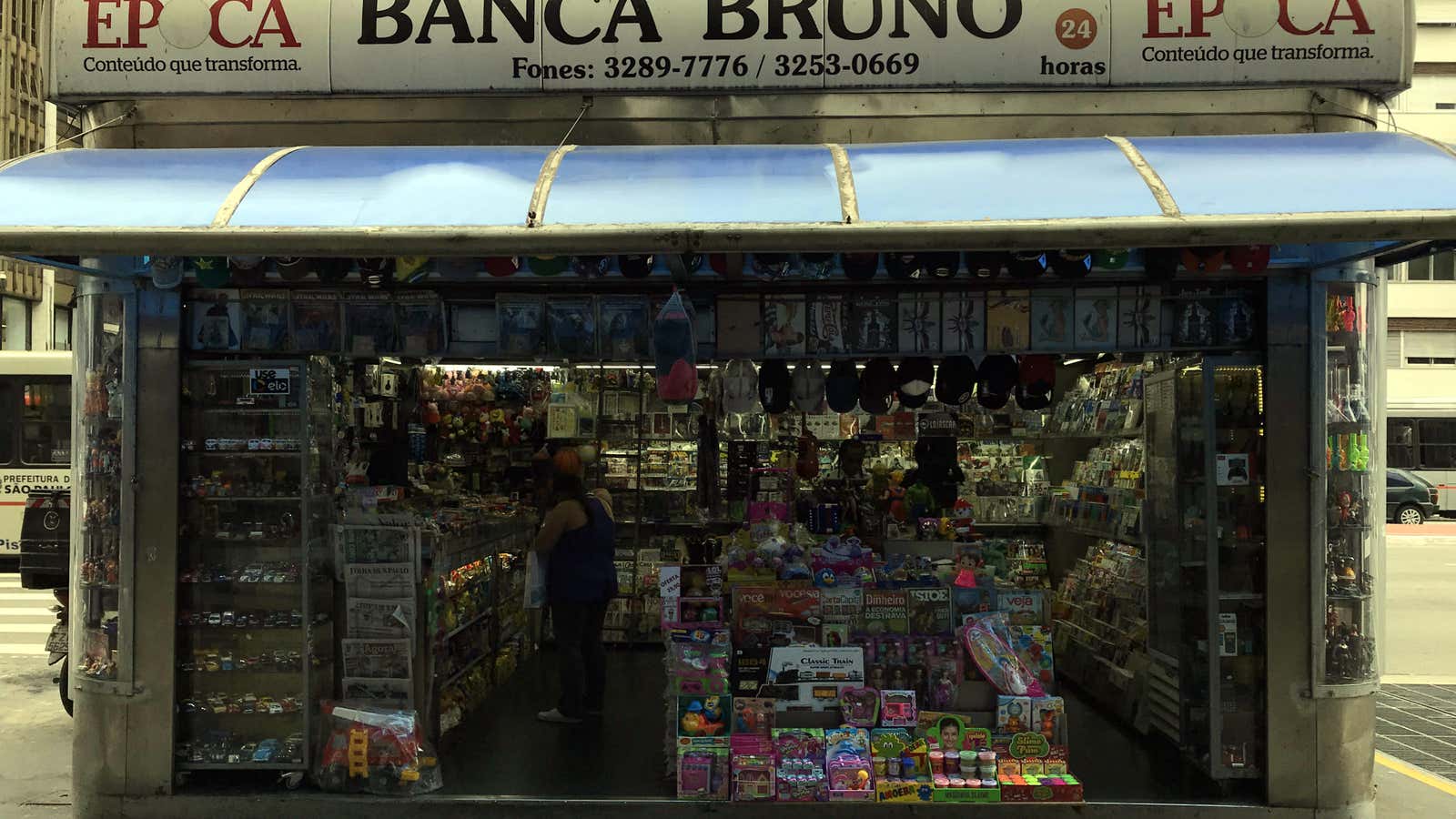The digital revolution that has torn through print journalism has also taken a toll on Bruno, a newsstand in São Paulo that’s been open for more than 30 years. Its sales dropped by more than half, and it only survived because it managed to adapt, diversifying its offerings. It offered fewer magazine and newspapers, instead focusing on products like drinks and cigarettes.
Bruno, like the other 3,000 newsstands in São Paulo (down from 5,000 about a decade ago), was helped by legislation. A municipal law passed in 2013 softened regulations and increased the number of products sidewalk stands are allowed to sell.
Its privileged location has been crucial. The newsstand is located on a sidewalk on Paulista, probably the country’s most famous avenue. The long street, surrounded by skyscrapers and the offices of big banks and corporations, has three shopping centers and its sidewalks are crowded with street sellers. Traffic is closed on Sundays and holidays, converting the avenue into one long pedestrian boulevard.
With that potential customer base at its disposal, and a wide array of products available, Bruno managed to offset its huge drop in sales, while still maintaining a staff of six people who work in two shifts, keeping the stand open from 6am until 10pm. The newsstand sustains three business partners, owners of four other newsstands along Paulista (the avenue hosts almost 20).
Other newsstands in the city haven’t been so lucky. In quiet residential areas, “for sale” signs are common. Earlier this year, local officials in one São Paulo district launched a program to remove abandoned newsstands.
Like Bruno, many newsstands are more like convenience stores. Or, they have focused on specific types of publications, specializing in comics, artsy zines and posters, foreign publications, or books.
Eronildo Bispo, one of the workers at the newsstand, took time to explain to Quartz how Bruno has managed to survive as the news business shifts from print to online. The interview has been lightly edited for length and clarity.
In terms of technology, what’s the big thing you know today that you wished you knew five years ago/when you started?
The arrival of the digital and the drop in sales. It really impacted us. Before, a newsstand was a newsstand. It had newspapers, comics, magazines, that kind of thing. It didn’t have any convenience store products like beverages, cigarettes, electronics. Today, it’s exactly the opposite. The editorial side of the newsstand is shrinking, and the convenience part is growing. We sell everything you can imagine, we just don’t sell perishable items.
What technology or tech service, that is not a giant company like Google or Apple, do you find is most useful in running your business?
We have our own management software that helps us with the buying, cataloging, and returning products. But nothing is external. The software was created by one of the owners of the newsstand. He coded it himself, and he sells it to other newsstands as well.
It’s similar to the kind of software you’d find at a supermarket like Extra or Carrefour, but it was adapted to a newsstand.
We have to adapt our business, because if you stop in time, you don’t survive. Many newsstands went bankrupt because they couldn’t adapt. That software is one element of the adaptation that we had to do to our business to survive.
From a technology standpoint, what can’t you do, that you think you should be able to?
I’d like to do more with digital promotion, like on Facebook and Instagram. We have even talked about it in the past, but we decided we wouldn’t do it because we already have a satisfying customer base here at Paulista, and we don’t need more. But if we had to do something, it would be that.
Has technology changed anything about how you manage your company’s money in the last five years?
It changed a lot. Today, without the software we use here, it would be impossible to manage the amount of products we sell. Before, a long time ago, they used to do it by hand, writing on notebooks. They managed it, but without the comfort that we have today.
What app on your phone do you find most useful for work?
WhatsApp is the one we use the most. It’s practical and fast. We use it for communication between employees, and to talk with suppliers and customers. We send a message to more assiduous clients, those who come to the newsstand a lot, when a product we know they’re interested has arrived.
What’s the newest competitive threat?
There’s a lot of competition here at Paulista. There are tens of newsstands here. It’s a lot. But we’ve learned how to deal with that, and we’ve been here for over 30 years.
There’s also the digital. But I think the worst is over. What had to drop in terms of sales has already dropped. If some other publication goes digital, there isn’t that much of an impact for us. There’s an impact for the customer, because they come here searching for it. And if we lose more editorial sales, we have the convenience sales to compensate.
Do you think the availability of self-driving cars might change your business?
I don’t see how that could happen so soon. It should take some 10 years to 15 years. Considering the articles we read, it will take some time. But I think that when it comes, it won’t have that much of an impact.
Can you imagine using bitcoin or incorporating the blockchain in your business?
I don’t know. I did get some apps to try it but I don’t see the advantage. And it’ll take a while before it really becomes something concrete for us.
